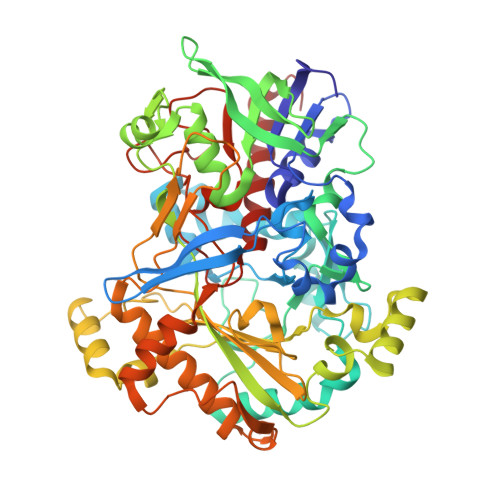The microenvironment surrounding FAD mediates its conversion to 8-formyl-FAD in Aspergillus oryzae RIB40 formate oxidase.
Doubayashi, D., Oki, M., Mikami, B., Uchida, H.(2019) J Biochem 166: 67-75
- PubMed: 30715389
- DOI: https://doi.org/10.1093/jb/mvz009
- Primary Citation of Related Structures:
5ZU2, 5ZU3 - PubMed Abstract:
Aspergillus oryzae RIB40 formate oxidase has Arg87 and Arg554 near the formyl group and O(4) atom of 8-formyl-flavin adenine dinucleotide (FAD), respectively, with Asp396 neighbouring Arg554. Herein, we probed the roles of these three residues in modification of FAD to 8-formyl-FAD. Replacement of Arg87 or Arg554 with Lys or Ala decreased and abolished the modification, respectively. Replacement of Asp396 with Ala or Asn lowered the modification rate. The observation of unusual effects of maintaining pH 7.0 on the modification in R87K, R554K and D396 variants indicates initial and subsequent processes with different pH dependencies. Comparison of the initial process at pH 4.5 and 7.0 suggests that the microenvironment around Arg87 and the protonation state of Asp396 affect the initial process in the native enzyme. Comparison of the crystal structures of native and R554 variants showed that the replacements had minimal effect on catalytic site structure. The positively charged Arg87 might contribute to the formation of an anionic quinone-methide tautomer intermediate, while the positively charged Arg554, in collaboration with the negatively charged Asp396, might stabilize this intermediate and form a hydrogen bonding network with the N(5)/O(4) region, thereby facilitating efficient FAD modification.
Organizational Affiliation:
Department of Applied Chemistry and Biotechnology, Graduate School of Engineering, University of Fukui, Fukuishi, Japan.

















